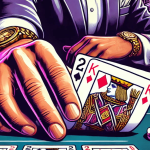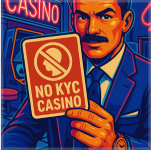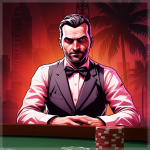What is a Poker Face: How to Read Facial Tells in Games
Find out what a poker face is and how it can be used for real advantages in games. This article teaches the basics of facial tells and poker faces.
Strategy
Remember that time you tried to hide your excitement when opening a birthday present? Or maybe, when you had to act cool after getting great news at work? That’s exactly what poker players do at the table – but with money on the line!
Here at CoinPoker, we know that keeping a straight face might be your best friend at the poker table. Whether you’re holding the best cards possible or trying to bluff your way out of trouble, hiding your emotions can mean the difference between winning big or going home empty-handed. Let’s explore how you can master this essential poker skill.

Definition: What Is a Poker Face?
When first starting out, many players will ask ‘what is a poker face? Straight from the dictionary, a poker face “is a deliberately neutral facial expression that reveals no emotion or information about one’s thoughts or intentions.”
Okay, so… what does that mean, exactly? Think of a poker face as your invisible mask at the table. Just like how superheroes use masks to hide their identity, your poker face hides your thoughts and feelings during a game. It’s such a powerful concept that it’s become famous outside of poker – you’ve probably heard Lady Gaga’s hit song “Poker Face” or heard someone use the phrase at work.
Here’s something interesting – having a poker face doesn’t mean looking like a robot. The secret is being consistent. Whether you’re holding amazing cards or terrible ones, your facial expression should look the same way every time. It’s like wearing your favorite comfortable outfit – it should feel natural and easy to maintain.
Uncontrolled facial expressions can give heaps of information to your opponents, for example:
- Your smile might tell everyone you’ve got great cards
- A frown could show you’re disappointed
- Looking nervous might reveal you’re bluffing
- Quick breathing might show you’re excited
- Fidgeting could signal you’re unsure
- Sitting up suddenly might mean you’re interested
- Looking away might mean you’re worried
When you master your poker face, it’s like having a secret superpower – other players have to guess what you’re thinking instead of reading it right off your face. It’s one of the first skills to learn on your way to becoming a professional poker player.
How Poker Face is Used in a Sentence
Let’s see how people talk about poker faces in real life:
- “Tom held his poker face when his boss announced layoffs – nobody knew he already had a new job lined up.”
- “Sarah’s poker face was so good, no one could tell she had the winning hand.”
- “My poker face saved me when I was bluffing with nothing.”
- “Even when he won the championship, his poker face never cracked.”
- “She could sell ice to penguins with that poker face of hers!”
The Origin of the Poker Face
Back in the 1800s, when poker games happened on riverboats and in saloons, clever players figured out something important: if they could hide their emotions, they’d win more money. It’s like how kids learn to hide their excitement when they’re playing hide and seek – the best players don’t give away their hiding spots.
The term “poker face” caught on because it perfectly described what good players were doing – keeping their faces as blank as the back of a playing card. These days, people use the phrase everywhere, from business meetings to card games, but it all started with those early poker players trying to outsmart each other.
What’s the Opposite of a Poker Face?
Think of the opposite of a poker face as having every thought and feeling show right on your face during a game. When players show all their reactions, it’s like giving away their cards before they even play them. Here are some common giveaways:
- Breaking into a huge grin when you get great cards
- Sighing when you get nothing useful
- Biting your lip when you’re bluffing at poker
- Shaking with excitement when you’re about to win big
- Slumping down when things go wrong
- Looking at your chips when you want to bet
- Clearing your throat when you’re nervous
- Freezing up when you’ve got a monster hand
- Talking too much when you’re unsure
These little habits are like holding up a sign that tells everyone exactly what you’re thinking – not great when you’re trying to win at poker!
Poker Face vs Face Cards
Let’s clear up something that confuses many new players – what’s the difference between a poker face and face cards? It’s pretty simple –- your poker face is the expression you wear at the table, while “face cards” are the Jacks, Queens, and Kings in the deck – the cards with royal faces on them.
Don’t confuse your poker face with face cards in the deck! Face cards – the Jacks, Queens, and Kings – are actually named for the royal faces printed on them. These regal cards are among the most valuable in the deck (second only to the Ace) and can help you make winning hands. While you can practice and control your poker face, face cards are simply dealt by chance. Both play important roles in the game, but in very different ways – your poker face is an early skill and beginner poker strategy you develop, while face cards are tools you use when luck puts them in your hand.

Why Do Players Need a Poker Face?
Having a good poker face is like having a shield in a video game – it protects you from your opponents. Whether you’re playing at your local card room, in our online poker tournaments, or at a friend’s house, keeping your emotions hidden gives you a huge advantage.
Let’s break down why it’s so important:
Protect Your Secrets:
- Keeps others guessing about your cards
- Stops people from spotting when you’re bluffing
- Hides whether you’re nervous or confident
- Makes your betting patterns harder to figure out
- Keeps your strategy under wraps
- Prevents others from knowing when you’re unsure
- Masks whether you’re on a winning or losing streak
Gain an Advantage:
- Makes you tougher to play against
- Helps you pull off successful bluffs
- Lets you win more when you have good cards
- Makes you look more professional
- Creates opportunities to trick opponents
- Helps you get away with more moves
- Makes your bets more believable
Feel the Mental Benefits:
- Boosts your confidence
- Keeps you calmer under pressure
- Helps you focus better
- Makes better decisions easier
- Stops you from getting too emotional
- Builds your patience
- Makes long games easier to handle
Here’s a cool tip: when you play online poker, you don’t need to worry about your actual poker face. This makes online games perfect for practicing other parts of poker while you work on your face-to-face game skills.
How to Master Your Poker Face – Top 5 Tips
Want to develop a killer poker face? It’s easier than you might think. Just like learning to ride a bike, it takes some practice at first, but soon, it’ll feel natural. Here’s your step-by-step guide to keeping your cool at the table:
#1: Control Your Reactions and Avoid Tells
Think of your poker face as a default expression – it should be the same every time. A “tell” is anything that gives away what you’re thinking. It’s like when your mom knows you’re lying because you always touch your nose. The key is finding a natural, comfortable expression and practicing it in front of a mirror. Use this same expression whether your cards are great or terrible, and keep your breathing nice and steady. Watch out for little facial twitches and stay aware of your unconscious habits. Do everything the same way each time – from how you look at your cards to how you place your chips.
Remember: Understanding what a poker face is means recognizing that it’s not just about trying to look tough or robotic – just comfortable and consistent.
#2: Manage Your Gaze and Glances
Your eyes can be like a leaky faucet – dripping information to your opponents. Just like how your dog looks at the treats before begging, poker players often look at their chips right before betting. Let’s fix that. Pick one spot to look at most of the time, and don’t stare at your chips when you’re planning to bet. Avoid looking too long at good cards, and keep the same looking pattern every hand. Use your side vision to watch others, create a routine for checking your cards, and look around the table naturally.
Think of it like playing hide and seek – the moment you look at your hiding spot, you give it away.
#3: Stay Cool and Relaxed
Your body can tell stories even when your face isn’t! It’s like trying to hide Christmas presents – the whole body gets involved in keeping the secret. Here’s how to stay cool: breathe like you’re taking a nice walk, and keep your hands still (imagine they’re relaxing in a warm bath). Don’t play with your chips like they’re stress toys, and find a comfy position and stick with it. Keep your shoulders relaxed, and use simple meditation tricks when stressed. Create routines that feel natural – think of yourself as a calm lake, still and peaceful. Stay as relaxed as you would watching TV. The same methods could also help you out if you find yourself on tilt in poker if you lose a big hand. Stay focused!
#4: Watch What You Say
Ever notice how people’s voices get squeaky when they’re excited? Or how they talk more when they’re nervous? Your voice can give away your cards faster than a hole in your pocket. Here’s how to keep control: stay quiet when you’re in a hand, and speak in your normal, everyday voice. Skip the nervous chatter and don’t explain your moves – save the strategy talk for later. Keep your tone steady and practice keeping calm while speaking. Have a few basic responses ready for common situations. Think of yourself as a cool radio DJ – smooth and steady.
#5: Stay Strong After Each Hand
The game isn’t over when the cards drop. You need to keep your poker face until everyone’s moved on to the next hand. Keep your cool by maintaining the same expression after winning or losing, and don’t show relief when your bluff works. Stay stone-faced until all cards are gone and avoid victory dances (save them for later!). Keep your cool during breaks and bounce back quickly from tough losses. Make every hand look the same – act like every hand is just another day at the office.
How to Spot Other Players’ Tells – Top 3 Tips
Reading other players is like being a detective – you’re looking for clues. When playing live poker games, knowing what to look for can help you make better decisions.
#1: Watch for Changes in Habits
Look for when people break their normal patterns: it’s when players suddenly start sitting up straight, betting at a different pace than usual, or breathing differently than they have been. Watch for changes in how they handle their poker chips, if they’re talking more or less than before, looking around in new ways, or taking longer to act than their usual timing. It’s like when your friend says they “totally don’t care” about something but keep checking their phone every minute.
#2: Look for Nervous Habits
Some things are hard to control, like shaky hands, fast breathing, or nervous chip fiddling. Watch for players gulping, their neck pulse racing, or tiny facial twitches they can’t hide. Keep an eye out for tense shoulders, unconscious eye movements, or faces getting red from excitement or stress. Remember, the evidence is in the little details!
#3: Connect the Dots
Link what you see with how they play: notice if their fast bets tend to show strength, or if slow plays reveal uncertainty. Pay attention to the way they stack their chips, how they prepare to bet, and where their eyes go before taking action. Study their posture when bluffing, any changes in their voice when betting, and their habits right before folding.
Body Language Tips for Success
Looking for more poker tips? Check out our poker strategy guide for a full toolbox of winning tricks:
Physical Control:
- Move like you’re in slow motion
- Keep your back straight but comfy
- Breathe like you’re relaxed at home
- Handle your chips like they’re part of a routine
- Make every action smooth and natural
- Find a comfy way to sit
- Create simple routines
- Stay loose and relaxed
- Keep everything smooth and easy
Mental Game:
- Focus like you’re watching your favorite movie
- Keep your emotions in check
- Think clear and simple
- Don’t let bad hands bug you
- Use simple relaxation tricks
- Handle stress like a pro
- Build up your gaming stamina
- Make decisions like a boss
- Stay happy no matter what
Come Practice With Us!
Ready to try out your poker face? At CoinPoker, we’ve got everything you need. You can practice in real games, test your skills live, and learn from others while building your confidence and working on strategies. Join tournaments to put it all together. We offer features like player chat so you can connect with others, learn new tricks, and watch your progress grow. Get tips from pros, play at your comfort level, and build your bankroll at your own pace.
Sign up to CoinPoker today and start playing! Whether you’re just starting out or looking to up your game, we’ve got the perfect table for you.
FAQs
Think of a poker face as your game-day mask – it’s a neutral expression that doesn’t show whether you’re holding aces or nothing at all. It’s your secret weapon for keeping opponents guessing.
The best poker face is one you can keep up all night. It’s not about looking mean or scary – it’s about being consistent and comfortable.
Start small. Practice your neutral expression in the mirror, use it in your home game, and gradually build up to using it in bigger games. Like learning any new skill, it gets easier with practice.
Having a poker face is like having a good lock on your front door – it keeps your secrets safe. Without one, you’re basically showing your cards to everyone at the table.
The biggest mistakes are trying too hard (looking like a robot), forgetting about it when things get exciting, showing relief after bluffs, and dropping your guard between hands. Keep it natural and consistent.




























